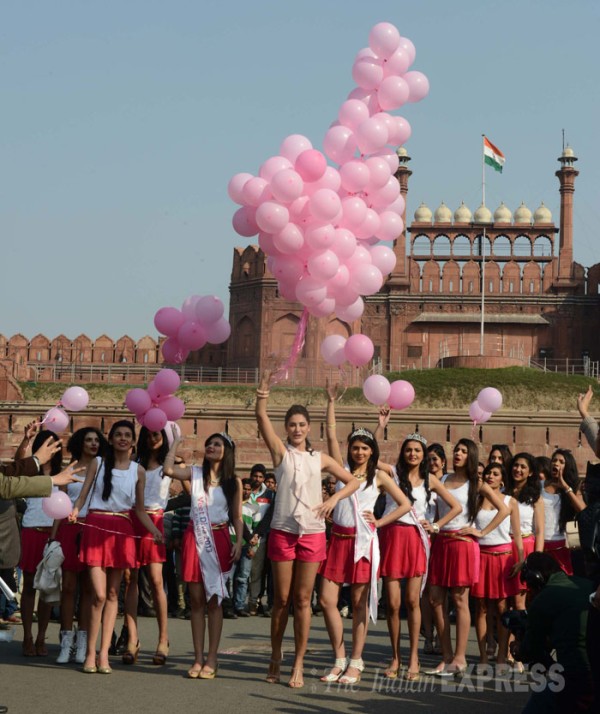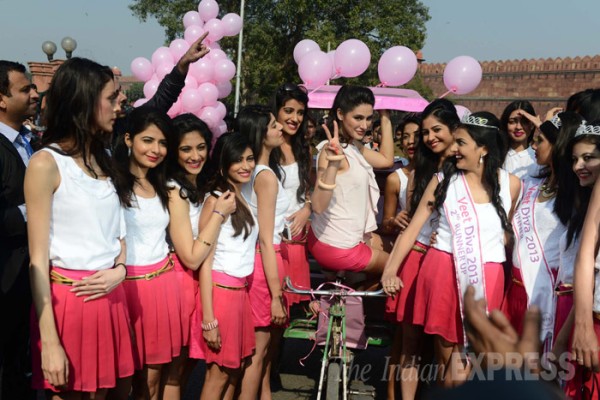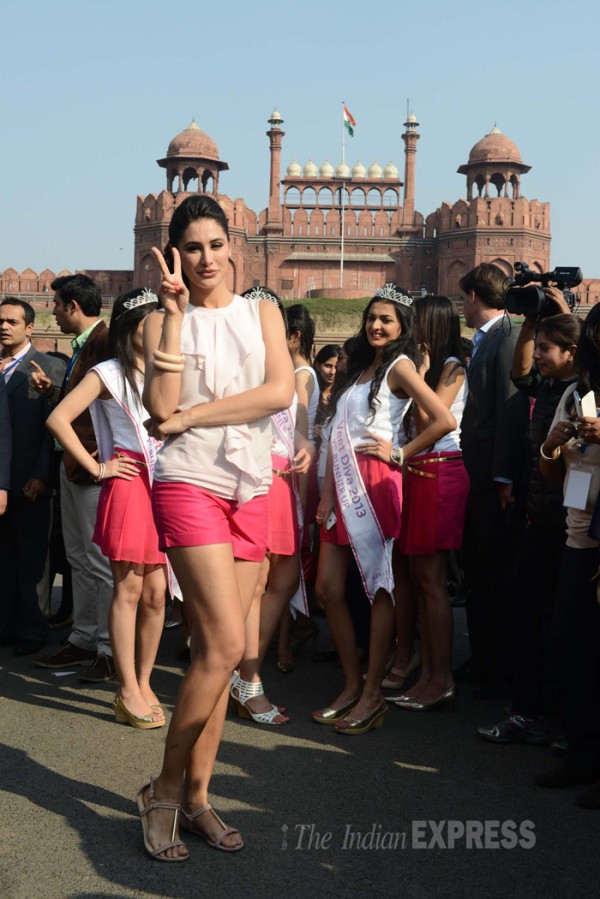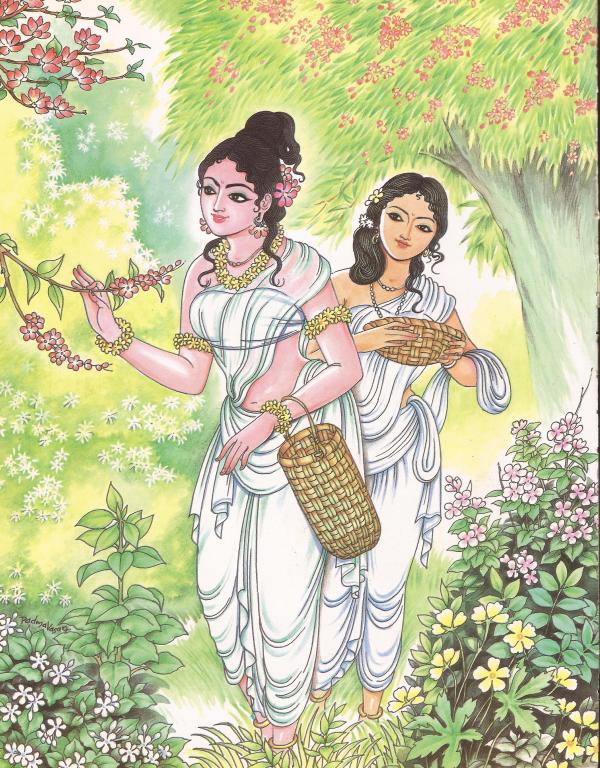Valentine Day and Hinduism
http://tamilandvedas.wordpress.com/tag/kamasutra/
By London Swaminathan
Post No.840 Date.14th February 2014 (valentine day)
Post No.840 Date.14th February 2014 (valentine day)
“ And of feminine beings I am fame (Kirti), prosperity (Sri), speech (Vak), memory (Smrti), intelligence (Medha), firmness (Dhrti) and patience (Kshama) – Bhagavad Gita 10—34
47 years ago, I and my brothers attended a meeting organised at Madurai Victoria Edward Hall (also known as Regal Talkies). Dr Ushar Budh of Sanskrit Department of Minnesota University addressed the gathering (Later he has become a Sanyai). He gave us an inspiring talk. He quoted some hymns from the Vedas and challenged the crowd to show a more beautiful love duet from any Indian film. Hindus never saw sex as a taboo, unlike other religions. But they were against any public display of it, which we see in today’s Western Valentine Day parties.
Marriage Hymns
The Vedic hymns used in the Hindu weddings are beautiful ones. They praise the bride as a Maha Rani (Great queen/Empress.
A few Vedic Wedding Mantras
सखा सप्तपदा भव ।
सखायौ सप्तपदा बभूव ।
सख्यं ते गमेयम् ।
सख्यात् ते मायोषम् ।
सख्यान्मे मयोष्ठाः ।
सखा सप्तपदा भव ।
सखायौ सप्तपदा बभूव ।
सख्यं ते गमेयम् ।
सख्यात् ते मायोषम् ।
सख्यान्मे मयोष्ठाः ।
You have walked seven steps with me; be my friend. We have walked seven steps together; let us be friends. Let me get your friendship. Let me not part from your friendship. May you not part from my friendship. [ Note: This is recited by the groom after taking the seven steps around the altar. (विवाह कर्मकाण्ड - vivaaha karmakaaNDa) ]
– ॐ –
धैरहं पृथिवीत्वम् ।
रेतोऽहं रेतोभृत्त्वम् ।
मनोऽहमस्मि वाक्त्वम् ।
सामाहमस्मि ऋकृत्वम् ।
सा मां अनुव्रता भव ।
धैरहं पृथिवीत्वम् ।
रेतोऽहं रेतोभृत्त्वम् ।
मनोऽहमस्मि वाक्त्वम् ।
सामाहमस्मि ऋकृत्वम् ।
सा मां अनुव्रता भव ।
I am the sky and you are the earth. I am the giver of energy and you are the receiver. I am the mind and you are the word. I am (saama) music and you are the song (RRik). You and I follow each other. [ Note: This is recited by the groom after taking the seven steps around the altar. (विवाह कर्मकाण्ड - vivaaha karmakaaNDa) ]
– ॐ –
चित्तिरा उपबर्हणं चक्षुरा अभ्यञ्जनम् ।
ध्यौर्भूमिः कोश आसीद्यदयात्सूर्या पतिम् ॥
चित्तिरा उपबर्हणं चक्षुरा अभ्यञ्जनम् ।
ध्यौर्भूमिः कोश आसीद्यदयात्सूर्या पतिम् ॥
Thought was pillow; and the sight the collyrium of the eyes; heaven and earth were her treasure box, when Surya went to her spouse.
(Matras are taken from samskrutam.com;thanks).
(Matras are taken from samskrutam.com;thanks).
Sex is sanctified in Hinduism. We can sing sexy songs like Gita Govindam in public. We can enact sexy acts in street corner dances known as Kama Dahanam, one day before Holi.
Lover/Beloved simile in Bhagavad Gita
Even in a religious book like the Bhagavad Gita we read a simile about lover and beloved! Arjuna says (11-44):
Therefore bowing down and prostrating my body before you, Adorable Lord, I seek thy grace. Thou ,O God shouldst bear with me as a father to his son, as a friend to his friend, as a lover to his beloved.
These human relations find in God their fullest realization and later Vaishnava literature utilizes these ideas more fully, says Dr Radhakrishnan in hiss Gita commentary.
Therefore bowing down and prostrating my body before you, Adorable Lord, I seek thy grace. Thou ,O God shouldst bear with me as a father to his son, as a friend to his friend, as a lover to his beloved.
These human relations find in God their fullest realization and later Vaishnava literature utilizes these ideas more fully, says Dr Radhakrishnan in hiss Gita commentary.
Rishi Status to sex writer
Vatsyayana , author of the Kamasutra and grammarian Panini were given the status of divine poets. No other religion gives so much importance to sex. But they always keep it within a limit. Family life is one of the four stages of a human being’s life. Brahmacharya, Grihastha (Married life), Vanaprastha (retired or forest life) and Sanyasa ( renunciation) are the four stages prescribed in Hindu scriptures.
Vatsyayana , author of the Kamasutra and grammarian Panini were given the status of divine poets. No other religion gives so much importance to sex. But they always keep it within a limit. Family life is one of the four stages of a human being’s life. Brahmacharya, Grihastha (Married life), Vanaprastha (retired or forest life) and Sanyasa ( renunciation) are the four stages prescribed in Hindu scriptures.
Dharma Artha Kama & Moksha
Hindu’s four goals in life are Dharma (religious law) Artha (wealth) Kama (Pleasure) & Moksha (liberation). The great Tamil poet Tiruvalluvar also divided his book Tirukkural into three parts Dharma, Artha and Kama in the same order. Oldest Tamil book Tolkappiam also refers to it. They never excluded Kama/ pleasure through married life.
Hindu’s four goals in life are Dharma (religious law) Artha (wealth) Kama (Pleasure) & Moksha (liberation). The great Tamil poet Tiruvalluvar also divided his book Tirukkural into three parts Dharma, Artha and Kama in the same order. Oldest Tamil book Tolkappiam also refers to it. They never excluded Kama/ pleasure through married life.
Sex in Tamil Veda Tirukkural
Tiru Valluvar, author of Tirukkural, used the Sanskrit word Kama though out his book (Kama gave the English word Amorous). Early Christian missionaries refused to translate the third chapter of the Tamil Veda Tirukkural, written around 5th century AD (31 BC is a fake date given by the Tamil enthusiasts. See my earlier posts).
The last couplet in the book runs like this,
Sweet are quarrels in love when the quarrels end in the bliss of a close embrace — Kural 1330
Is there a heaven happier than the sulking here of hearts that unite in love like water and earth — Kural 1323.
Sweet are quarrels in love when the quarrels end in the bliss of a close embrace — Kural 1330
Is there a heaven happier than the sulking here of hearts that unite in love like water and earth — Kural 1323.
Roman poet Publius terentius afer (190-159 BC) sais in Latin
‘Amarantium irae amoris integrationist’
‘Amarantium irae amoris integrationist’
“The quarrels of lovers are the renewal of love.” Andria. Act iii. Sc. 3, 23. (555.)
Another quote giving the same view
Another quote giving the same view
The quarrels of lovers are like summer showers, that leave the country more verdant and beautiful.
—Madame Necker
—Madame Necker
Gita Govindam of Jayadeva
Jeyadeva’s Gita Govindam is sung in all the traditional Bhajans in South India. Some of them are considered very sexy. But that was divine love, far above the carnal love. Swami Vivekananda, in his lecture on Gopi’s , says that their love towards Krishna was divine. Even to understand this love one’s heart must be as pure as Sukha’s, Vyasa’s son. Incidentally the earliest reference to Gopis is in the 2000 year old Sangam Tamil literature!
Jeyadeva’s Gita Govindam is sung in all the traditional Bhajans in South India. Some of them are considered very sexy. But that was divine love, far above the carnal love. Swami Vivekananda, in his lecture on Gopi’s , says that their love towards Krishna was divine. Even to understand this love one’s heart must be as pure as Sukha’s, Vyasa’s son. Incidentally the earliest reference to Gopis is in the 2000 year old Sangam Tamil literature!
The devotional movement laid several paths to reach God. One can see God as his master or a lover or a friend. In the Nayaka- Nayaki (hero/heroine) Bhava one can see God as a lover. In Tamil Nadu Saivite and Vaishnavite girls fast during a particular month (December/January) singing the glory of Shiva and Vishnu as lovers. Manikka Vasagar’s Tiruvembavai and Andal’s Tiruppavai have such songs.
Though we have some sex manual in Greek and songs similar to Nayaka/Nayaki in the Bible, they were no comparison to what we have here in Sanskrit and Tamil literature.
Love marriage is one of the eight types marriage approved by the Hindu scriptures. Swayamvaram, which is not found anywhere in the world, is a unique Hindu way of a woman choosing her would be husband from among her suitors. This was mainly done by the royal families.
Except the public display of sex, all the modern methods were tried and tested in India.
Contact swami_48@yahoo.com
Pictures are taken from the news papers and Souvenirs.
Posted in UNCATEGORIZED
Tagged KAMASUTRA, VALENTINE DAY AND RELIGION
Techniques of Secret Writing in India

Techniques of Secret Writing in India
During war times and military expeditions, army personnel use coded language so that the enemies wouldn‘t understand the message. But in the ancient world this secret language was used for different purposes. According to encyclopaedias it was used in Egypt 5000 years ago followed by Greece. Though the Vedic seers sang that they delight speaking in secret language we are not able to give concrete examples. Scholars have acknowledged the symbolism in the Vedas, but not the encrypted language.
When Vyasa requested Lord Ganesh to write the longest epic in the world, Lord Ganesh agreed to do it on a condition. He will have to write it without stopping. If it all Vyasa couldn’t compose the couplets that fast, he has to find another person to do the job. Clever Vyasa agreed to do it, but put one condition to Lord Ganesh that he should write only when he understood what he wrote. There started the puzzles, encrypted language etc. Once again we have no proof for the puzzles or encrypted language from Mahabharata, though this story is popular. Ancient Hindus followed a system called Katapayadi system to remember the words and numbers easily. This system assigned letters to numerals. No 18= JaYa (old name of Mahabharata).
Personally I think the coded language evolved in India and I will attribute the above facts as a proof for this.
But Dr.Simon Sing, a London based author, gives concrete example of encrypted language in his book ‘The Code Book’. It is very interesting that we have the first example in the sex manual- Kama Sutra!

64 Arts for Women
Following is an excerpt from his book:
“ One of the earliest descriptions of encryption by substitution appears in the Kama Sutra, a text written in the fourth century AD by the Brahmin scholar Vatsyayana, but based on manuscripts dating back to fourth century BC. The Kama sutra recommends that women should study 64 arts, such as cooking dressing, massage and preparation of perfumes. The list also includes some less obvious arts, namely conjuring, chess, book binding and carpentry. Number 45 on the list is Mlechita-vikalpa, the art of secret writing, advocated in order to help women conceal the details of their liaisons. One of the recommended techniques is to pair letters of the alphabet at random, then substitute each letter in the original message with its partner. If we apply the principle to the Roman alphabet, we could pair letters as follows:
A D H I K M O R S U W Y Z
V X B G J C Q L N E F P T
Then, instead of MEET AT MIDNIGHT, the sender would write CU UZ VZ CGXSGIBZ. This form of secret writing is called a substitution cipher because each letter in the plaintext is substituted for a different letter, thus acting in a complimentary way to the transposition of cipher. In transposition each letter retains its identity but changes its position, where as in substitution each letter change its identity but retains its position.
The first documented use of substitution cipher for military purposes appears in Julius Caesar’s Gallic Wars. Caesar describes how he sent a message to Cicero, who was besieged and on the verge of surrendering”.
Lot of interesting anecdotes are in the book. Simon Sing’s another popular book is The Fermat’s Last theorem.
Please read my earlier posts
- Hindu’s Magic Numbers 18, 108, 1008
- Love Letters from Ancient India
- பார்ப்பனிக்கு வடமொழிச் சீட்டு
Posted in UNCATEGORIZED
Sex Mantras and Talismans in Egypt and Atharva Veda
Picture: This is a symbol from Atharva Veda
This is Part 5 in Indo-Egyptian Connections. Please read
part 1. Did Indians build Egyptian Pyramids?
Part 2. Vedas and Egyptian Pyramid Texts
3. Vishnu in Egyptian Pyramids
4. Hindu Gods in Egyptian Pyramids
before reading this 5th part: London Swaminathan.
During Valentine Day and other occasions girls and women are sent cards with the picture of an arrow piercing the heart of a woman. Though many of us are familiar with such Greeting Cards, a lot of people don’t know this symbol has come from the Atharva Veda. Throughout Sanskrit literature we read Manmathan, God Of Love, shooting five arrows made up of flowers to pierce the heart of a lover. We see it first in the Vedas in the earliest time. The concept of Cupid’s arrow has travelled to different parts of the world from India.
Hindus scored many firsts in the world: First Grammar book in the world—Ashtadyaye of Panini, First Sex Manual—Kama Sutra of Vatsyayana, First Dictionary of Synonyms—Amarakosham of Amarasimhan, First religious Book- Rig Veda, First Maths Book with Pythagoras Theorem etc by Bodhayana, First Logic Book …………I can keep on adding over 100 Firsts. But that is beyond the scope of this article.
Read the Atharva Veda Mantra given below and note the words Heart, Arrow etc.
III, 25. Charm to arouse the passionate love of a woman.
1. May (love), the disquieter, disquiet thee; do not hold out upon thy bed! With the terrible arrow of Kâma (love) do I pierce thee in the heart.2. The arrow, winged with longing, barbed with love, whose shaft is undeviating desire, with that, well-aimed, Kâma shall pierce thee in the heart!
3. With that well-aimed arrow of Kâma which parches the spleen, whose plume flies forward, which burns up, do I pierce thee in the heart.
4. Consumed by burning ardour, with parched mouth, do thou (woman) come to me, pliant, (thy) pride laid aside, mine alone, speaking sweetly and to me devoted!
5. I drive thee with a goad from thy mother and thy father, so that thou shalt be in my power, shalt come up to my wish.
6. All her thoughts do ye, O Mitra and Varuna, drive out of her! Then, having deprived her of her will put her into my power alone!
3. With that well-aimed arrow of Kâma which parches the spleen, whose plume flies forward, which burns up, do I pierce thee in the heart.
4. Consumed by burning ardour, with parched mouth, do thou (woman) come to me, pliant, (thy) pride laid aside, mine alone, speaking sweetly and to me devoted!
5. I drive thee with a goad from thy mother and thy father, so that thou shalt be in my power, shalt come up to my wish.
6. All her thoughts do ye, O Mitra and Varuna, drive out of her! Then, having deprived her of her will put her into my power alone!
II, 30. Charm to secure the love of a woman.
1. As the wind tears this grass from the surface of the earth, thus do I tear thy soul, so that thou, woman, shalt love, shalt not be averse to me!
2. If ye, O two Asvins, shall unite and bring together the loving pair-united are the fortunes of, both of you (lovers), united the thoughts, united the purposes!
3. When birds desire to chirp, lustily desire to chirp, may my call go there, as an arrow-point upon the shaft!
4. What is within shall be without, what is without shall be within! Take captive, O herb, the, soul of the maidens endowed with every charm!
5. Longing for a husband this woman hath come, I have come longing for a wife, As a loudly neighing horse I have attained to my good fortune!
2. If ye, O two Asvins, shall unite and bring together the loving pair-united are the fortunes of, both of you (lovers), united the thoughts, united the purposes!
3. When birds desire to chirp, lustily desire to chirp, may my call go there, as an arrow-point upon the shaft!
4. What is within shall be without, what is without shall be within! Take captive, O herb, the, soul of the maidens endowed with every charm!
5. Longing for a husband this woman hath come, I have come longing for a wife, As a loudly neighing horse I have attained to my good fortune!
(Translation by Maurice Bloomfield, Year 1897).
Now read the Egyptian ‘Mantra’:
We have seen the attributes of Egyptian God Thoth in the Fifth part of this series. One other attribute of Thoth is his skill in magic. Thoth knew magic spells. It was known that he possessed spells such as this one, which was cast to ensure that one’s love was returned: “should she drink, eat or sleep with anyone else, I shall cast upon her ear, I shall cast a spell upon her breath, I shall cast a spell upon her three physical apertures; but in particular I shall cast a spell upon her vulva, which I wish to penetrate, until she comes to me and until I know what is in her heart, what she has been doing, what she is thinking of now, immediately, immediately’ (National Library, Paris, Greek Manuscript, IV 147-153).
Picture: T shirt with Manmatha’s arrow as described in Atharva Veda
AC Das View
A.C.Das showed that the Egyptian religion has a close similarity with the worship of gods –Siva, Kama and Kalaratri. He thought it is probable that the Egyptians had the knowledge of a god equivalent to Brahma ( AC Das –Rig Vedic India, Vol.II,Ch.XII). Das believed that the Egyptians migrated from Pandyan Kingdom in the transition from Vedic to Puranic periods.
Double statue of Amenemhet III (1844-1797 BC) has fish emblem like the Pandyas of Tamil Nadu.
Daksha -Shiva clash in Egypt
Indians are very familiar with the clash between Daksha and Lord Shiva. This story is also found in Egyptian literature in a slightly different way. Once when Daksha performed a big Yagna (Fire Sacrifice), Sati went to attend it uninvited. Daksha spoke to her rudely insulting her husband Shiva in front all those assembled. Sati (Parvati) was so upset that she jumped into fire rather than hearing the insults. Hearing this, Shiva became furious and destroyed the Yaga of Daksha. He carried his wife’s body on his shoulder like an insane person. Vishnu pacified his anger after cutting the body of Sati with his Sudarsana chakra (Boomerang used by Vishnu). Sati’s body parts fell in different parts of the country and those places became holy shrines of Goddess Shakti.
Egyptian Version:
Osiris was one of the oldest gods of Egypt. He was worshipped for 3400 years until 400 AD. He was compared with Lord Shiva. His parents were Geb and Nut. He was born with four siblings including his sister Isis, who became his consort. His adversary was Seth. Isis gave birth to god Horus by impregnating herself with the semen of Osiris after his death. Seth found Osiris body and cut into 14 pieces and scattered them along the Nile valley. But Seth missed Osris’ penis. Isis found all the parts and buried them at the sites of various sanctuaries. She restored the penis with replica which became the focus of Osirian cult. This is similar to our Shiva Linga worship.
Both the Shiva –Daksha clash and Osiris- Seth clash are symbolical stories. The scattering of the body parts was allegorized with the winnowing and scattering of grains in the fields.
Jain Statues and Egyptian Statues
Jain Thirtankara statues in India look like Egyptian Pharaoh’s statues. Both the figures with bare and broad shoulders stand straight. No one can miss the similarities. We don’t know how this came about. Of the 14 Jain Manus, one of them was Ksemenkara. We have one pharaoh with the name Menkaure.
Nemi was one of the Puranic kings who mummified his body like the Egyptians. He was one of the 24 Jain Thirtankaras.
Abyados was the first capital of ancient Egypt. Peribsen was one of the pharaohs. All these names are similar to Jain names. The pharaohs’ names end with Sen, Khet or Athen. We have all these suffixes in India as Sena, Ketu and Athan. Mahabharata Who’s Who? gives scores of names with Sena and Ketu. Tamil Chera kings have Athan, Kuttuvan suffixes in their names. According to Puranas, Chakora was ruled by Chandra Ketu. We have a big city Saqquara in Egypt. In the earlier parts, I have dealt with the maze (Chakra) in the city.
Contd…………………… contact swami_48@yahoo.com
**************






2 comments:
Excellent ....great work ....lots of info ... finally found something really useful on internet....
Excellent ....great work ....lots of info ... finally found something really useful on internet....
Post a Comment